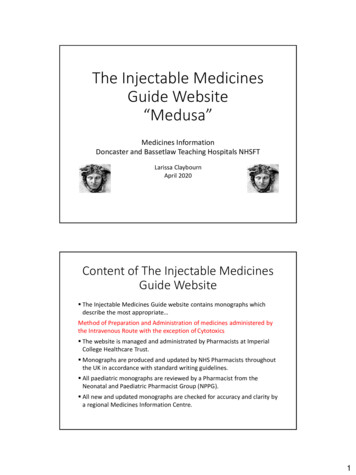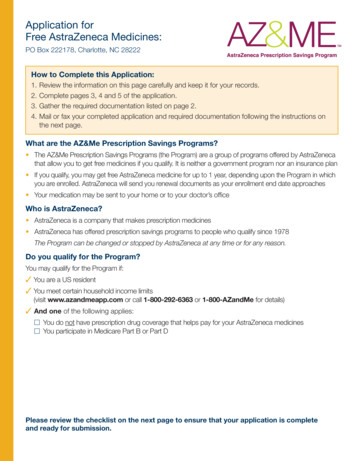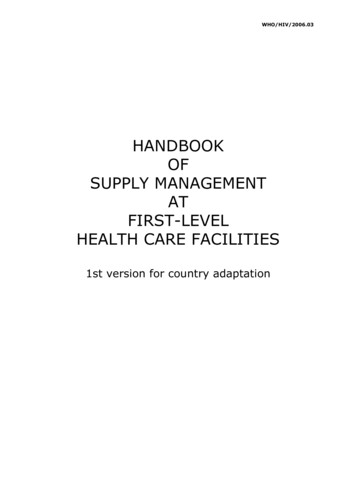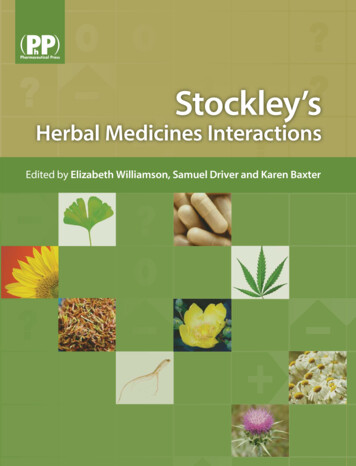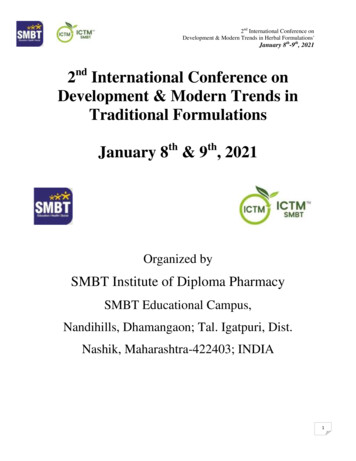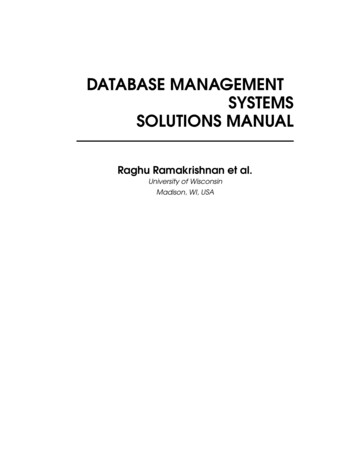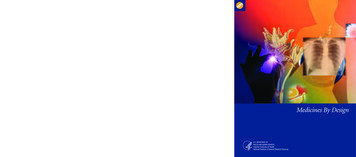
Transcription
AT T E N T I O N R E A D E R SWe would like your comments on Medicines By Design.Please give us your opinion by filling out this postage-paid response card.1.Extent to which the publication held your interest2.Understandability3.Amount and type of information presented4.Join our Findings mailing list. For sample issues,see http://publications.nigms.nih.gov/findings.q I would like to receive Findings, a magazine thatprofiles two NIGMS-supported scientists, featuresbrief descriptions of recent clinically relevantresearch, and includes a crossword puzzle basedon words used in the articles.q I would like to receive a free CD-ROM containingNIGMS science education booklets on topics such ascell biology, chemistry, genetics, pharmacology, andstructural biology. These booklets are geared towarda high school and early college audience. Printcopies of the publications can be ordered mUsefulness and value of such a publicationMedicines By DesignPlease comment on whether Medicines By Design helped youlearn more about:Name1.Pharmacology research2.What it’s like to be a scientistAddressState3.The excitement of biomedical research todayZip CodeNational Institutes of HealthNational Institute of General Medical SciencesE-mail (optional)Phone (optional)Other Comments:U.S. DEPARTMENT OFHEALTH AND HUMAN SERVICESCityNIH Publication No. 06-474Reprinted July 2006http://www.nigms.nih.govU.S. DEPARTMENT OFHEALTH AND HUMAN SERVICESNational Institutes of HealthNational Institute of General Medical Sciences
What Is NIGMS?Discrimination ProhibitedAccessibilityThe National Institute of General Medical SciencesUnder provisions of applicable public laws enactedThis publication can be made available in(NIGMS) supports basic biomedical research onby Congress since 1964, no person in the Unitedformats that are more accessible to peoplegenes, proteins, and cells. It also funds studies onStates shall, on the grounds of race, color, nationalwith disabilities. To request this material in afundamental processes such as how cells commu origin, handicap, or age, be excluded from partici-different format, contact the NIGMS Officenicate, how our bodies use energy, and how wepation in, be denied the benefits of, or be subjectedof Communications and Public Liaison atrespond to medicines. The results of this researchto discrimination under any program or activity301-496-7301, TDD 301-402-6327; send e-mailincrease our understanding of life and lay the(or, on the basis of sex, with respect to any educa-to info@nigms.nih.gov; or write to the office atfoundation for advances in the diagnosis, treatment,tion program or activity) receiving Federal financialthe following address: 45 Center Drive MSCand prevention of disease. The Institute’s researchassistance. In addition, Executive Order 111416200, Bethesda, MD 20892-6200. If you havetraining programs produce the next generation ofprohibits discrimination on the basis of age byquestions about this publication, you can usebiomedical scientists, and NIGMS has programs tocontractors and subcontractors in the performancethe same contact information to reach the writer,encourage minorities underrepresented in biomedicalof Federal contracts, and Executive Order 11246Alison Davis, Ph.D.and behavioral science to pursue research careers.states that no federally funded contractor mayNIGMS supported the research of most of thediscriminate against any employee or applicantscientists mentioned in this booklet.for employment because of race, color, religion,sex, or national origin. Therefore, the programs ofDisclaimerTrade names have been used throughout thisbooklet to illustrate concepts about medicinesthat are familiar to readers. The mention ofspecific products is not an endorsement of theiruse or effectiveness.the National Institute of General Medical Sciencesmust be operated in compliance with these lawsand Executive Orders.Additional Copiesand Web LinksTo order additional copies of Medicines By DesignDEPT OF HEALTH AND HUMAN SERVICESNATIONAL INSTITUTES OF HEALTHNATIONAL INSTITUTE OF GENERAL MEDICAL SCIENCES45 CENTER DR RM 3AN.32 MSC 6200BETHESDA MD 20892-6200OFFICIAL BUSINESSPENALTY FOR PRIVATE USE 300or other free publications available fromNIGMS, go to htm or use the contactinformation above.Medicines By Design is available online TIONAL INSTITUTES OF HEALTHNATIONAL INSTITUTE OF GENERAL MEDICAL SCIENCESOFFICE OF COMMUNICATIONS AND PUBLIC LIAISON45 CENTER DR RM 3AN.32 MSC 6200BETHESDA MD 20814-9692
Medicines By DesignU.S. DEPARTMENT OFHEALTH AND HUMAN SERVICESNational Institutes of HealthNational Institute of General Medical SciencesNIH Publication No. 06-474Reprinted July 2006http://www.nigms.nih.gov
Written by Alison Davis, Ph.D., under contracts263-MD-205019 and 263-MD-212730.Produced by the Office of Communications and Public LiaisonNational Institute of General Medical SciencesNational Institutes of HealthU.S. Department of Health and Human Services
ContentsFO R E W O R D: A V I SI T T O T H E D O C T O R2C H A PTE R 1: A BC S O F P H AR MAC O LO GY4A Drug’s Life5Perfect Timing9Fitting In10Bench to Bedside: Clinical Pharmacology13Pump It Up14C H A PTE R 2: BO DY, H E AL T H YS E LF16The Body Machine16River of Life18No Pain, Your Gain20Our Immune Army23A Closer Look26C H A PTE R 3: DR U GS F R O M N AT U R E , T H E N AN D N O W28Nature’s Medicine Cabinet28Ocean Medicines30Tweaking Nature33Is It Chemistry or Genetics?34Testing I, II, III36C H A PTE R 4: M O L EC U LE S T O ME D I C I N E S38Medicine Hunting3821st-Century Science40Rush Delivery41Transportation Dilemmas43Act Like a Membrane44The G Switch46M E DI C I NE S FO R TH E F U T U R E48GLO S SARY50
Foreword: A Visit to the DoctorMay 17, 2050—You wake up feeling terrible,That’s right, your DNA. Researchers predict thatthe medicines of the future may not only look andand you know it’s time to see a doctor.In the office, the physician looks you over,work differently than those you take today, buttomorrow’s medicines will be tailored to yourgenes. In 10 to 20 years, many scientists expectlistens to your symptoms, and prescribesthat genetics —the study of how genes influenceactions, appearance, and health—will pervadea drug. But first, the doctor takes a lookat your DNA.medical treatment. Today, doctors usually give youan “average” dose of a medicine based on yourbody size and age. In contrast, future medicinesmay match the chemical needs of your body, asinfluenced by your genes. Knowing your uniquegenetic make-up could help your doctor prescribethe right medicine in the right amount, to boost itseffectiveness and minimize possible side effects.Along with these so-called pharmacogeneticapproaches, many other research directions willhelp guide the prescribing of medicines. Thescience of pharmacology—understanding thebasics of how our bodies react to medicines andhow medicines affect our bodies—is already avital part of 21st-century research. Chapter 1,“ABCs of Pharmacology,” tracks a medicine’sjourney through the body and describes differentavenues of pharmacology research today.
Medicines By Design I Foreword 3Stay tuned for changes in the way you takedelivery, discussed in Chapter 4, “Molecules tomedicines and in how medicines are discoveredMedicines,” is advancing progress by helping getand produced. In Chapter 2, “Body, Heal Thyself,”drugs to diseased sites and away from healthy cells.learn how new knowledge about the body’s ownMedicines By Design aims to explain howmolecular machinery is pointing to new drugs. Asscientists unravel the many different ways medicinesscientists understand precisely how cells interact inwork in the body and how this information guidesthe body, they can tailor medicines to patch gapsthe hunt for drugs of the future. Pharmacologyin cell communication pathways or halt signalingis a broad discipline encompassing every aspectcircuits that are stuck “on,” as in cancer.of the study of drugs, including their discoveryScientists are developing methods to haveand development and the testing of their actionanimals and plants manufacture custom-madein the body. Much of the most promisingmedicines and vaccines. Experimental chickenspharmacological research going on at universitiesare laying medicine-containing eggs. Researchersacross the country is sponsored by the Nationalare engineering tobacco plants to produce newInstitute of General Medical Sciences (NIGMS),cancer treatments. Topics in Chapter 3, “Drugsa component of the National Institutes of HealthFrom Nature, Then and Now,” will bring you up(NIH), U.S. Department of Health and Humanto speed on how scientists are looking to natureServices. Working at the crossroads of chemistry,for a treasure trove of information and resourcesgenetics, cell biology, physiology, and engineering,to manufacture drugs.pharmacologists are fighting disease in the laboratoryAdvances in understanding the roots of diseaseare leading to new ways to package tomorrow’smedicines. Along with biology and chemistry, theengineering and computer sciences are leading usto novel ways of getting drugs where they needto go in the body. Cutting-edge research in drugand at the bedside.
CHAPTER 1ABCs of PharmacologyKnow why some people’s stomachs burn aftermedicines affect the body. Pharmacology is oftenthey swallow an aspirin tablet? Or why aconfused with pharmacy, a separate discipline inswig of grapefruit juice with breakfast can raisethe health sciences that deals with preparing andblood levels of some medicines in certain people?dispensing medicines.Understanding some of the basics of the scienceFor thousands of years, people have looked inof pharmacology will help answer these questions,nature to find chemicals to treat their symptoms.and many more, about your body and the medicinesAncient healers had little understanding of howyou take.various elixirs worked their magic, but we knowSo, then, what’s pharmacology?much more today. Some pharmacologists studyDespite the field’s long, rich history and impor how our bodies work, while others study thetance to human health, few people know muchchemical properties of medicines. Others investi about this biomedical science. One pharmacologistgate the physical and behavioral effects medicinesjoked that when she was asked what she did for ahave on the body. Pharmacology researchers studyliving, her reply prompted an unexpected question:drugs used to treat diseases, as well as drugs of“Isn’t ‘farm ecology’ the study of how livestockabuse. Since medicines work in so many differentimpact the environment?”ways in so many different organs of the body,Of course, this booklet isn’t about livestock oragriculture. Rather, it’s about a field of science thatpharmacology research touches just about everyarea of biomedicine.studies how the body reacts to medicines and howA Juicy StoryDid you know that, in some people, a single glassof grapefruit juice can alter levels of drugs usedto treat allergies, heart disease, and infections?Fifteen years ago, pharmacologists discoveredthis “grapefruit juice effect” by luck, after givingvolunteers grapefruit juice to mask the taste of amedicine. Nearly a decade later, researchers fig ured out that grapefruit juice affectsmedicines by lowering levels of adrug-metabolizing enzyme, calledCYP3A4, in the intestines.More recently, Paul B. Watkins ofthe University of North Carolina atChapel Hill discovered that other juices like Seville(sour) orange juice—but not regular orangejuice—have the same effect on the body’s handlingof medicines. Each of 10 people who volunteeredfor Watkins’ juice-medicine study took a standarddose of Plendil (a drug used to treat high bloodpressure) diluted in grapefruit juice, sour orangejuice, or plain orange juice. The researchers meas ured blood levels of Plendil at various timesafterward. The team observed that both grapefruitjuice and sour orange juice increased blood levels ofPlendil, as if the people had received a higherdose. Regular orange juice had no effect. Watkinsand his coworkers have found that a chemical com mon to grapefruit and sour oranges,dihydroxybergamottin, is likely the molecular cul prit. Another similar molecule in these fruits,
Medicines By Design I ABCs of Pharmacology 5Many scientists are drawn to pharmacologyA Drug’s Lifebecause of its direct application to the practice ofHow does aspirin zap a headache? What happensmedicine. Pharmacologists study the actions ofafter you rub some cortisone cream on a patch ofdrugs in the intestinal tract, the brain, the muscles,poison ivy-induced rash on your arm? How doand the liver—just a few of the most commondecongestant medicines such as Sudafed dry upareas where drugs travel during their stay in theyour nasal passages when you have a cold? Asbody. Of course, all of our organs are constructedmedicines find their way to their “job sites” in thefrom cells, and inside all of our cells are genes.body, hundreds of things happen along the way.Many pharmacologists study how medicinesOne action triggers another, and medicines workinteract with cell parts and genes, which in turnto either mask a symptom, like a stuffy nose, orinfluences how cells behave. Because pharmacologyfix a problem, like a bacterial infection.touches on such diverse areas, pharmacologistsmust be broadly trained in biology, chemistry, andmore applied areas of medicine, such as anatomyand physiology.A Model for SuccessTurning a molecule into a good medicine is neithereasy nor cheap. The Center for the Study of DrugDevelopment at Tufts University in Boston esti mates that it takes over 800 million and a dozenyears to sift a few promising drugs from about5,000 failures. Of this small handful of candidatedrugs, only one will survive the rigors of clinicaltesting and end up on pharmacy shelves.That’s a huge investment for what may seema very small gain and, in part, it explains the highcost of many prescription drugs. Sometimes, prob lems do not show up until after a drug reachesthe market and many people begin taking the drugroutinely. These problems range from irritating sideeffects, such as a dry mouth or drowsiness, to lifethreatening problems like serious bleeding or bloodclots. The outlook might be brighter if pharmaceuticalscientists could do a better job of predicting howpotential drugs will act in the body (a science calledpharmacodynamics), as well as what side effects thedrugs might cause.One approach that can help is computer mod eling of a drug’s properties. Computer modelingcan help scientists at pharmaceutical and biotech nology companies filter out, and abandon earlyon, any candidate drugs that are likely to behavebadly in the body. This can save significantamounts of time and money.Computer software can examine the atom-by atom structure of a molecule and determinehow durable the chemical is likely to be insidea body’s various chemical neighborhoods. Willthe molecule break down easily? How well willthe small intestines take it in? Does it dissolveeasily in the watery environment of the fluidsthat course through the human body? Will thedrug be able to penetrate the blood-brain barrier?Computer tools not only drive up the successrate for finding candidate drugs, they can alsolead to the development of better medicineswith fewer safety concerns.
6National Institute of General Medical avenousIntestinesA drug’s life in the body.Medicines taken by mouth(oral) pass through the liverbefore they are absorbedinto the bloodstream. Otherforms of drug administrationbypass the liver, entering theblood directly.
Medicines By Design I ABCs of Pharmacology 7IntramuscularSubcutaneousDrugs enter different layersof skin via intramuscular,subcutaneous, or transdermaldelivery methods.TransdermalSkinScientists have names for the four basic stagesa large amount may be destroyed by metabolicof a medicine’s life in the body: absorption, distri enzymes in the so-called “first-pass effect.” Otherbution, metabolism, and excretion. The entireroutes of drug administration bypass the liver,process is sometimes abbreviated ADME. The firstentering the bloodstream directly or via the skinstage is absorption. Medicines can enter the bodyor lungs.in many different ways, and they are absorbedOnce a drug gets absorbed, the next stage iswhen they travel from the site of administrationdistribution. Most often, the bloodstream carriesinto the body’s circulation. A few of the mostmedicines throughout the body. During this step,common ways to administer drugs are oral (swal side effects can occur when a drug has an effect inlowing an aspirin tablet), intramuscular (getting aan organ other than the target organ. For a painflu shot in an arm muscle), subcutaneous (injectingreliever, the target organ might be a sore muscleinsulin just under the skin), intravenous (receivingin the leg; irritation of the stomach could be achemotherapy through a vein), or transdermalside effect. Many factors influence distribution,(wearing a skin patch). A drug faces its biggestsuch as the presence of protein and fat moleculeshurdles during absorption. Medicines takenin the blood that can put drug molecules out ofby mouth are shuttled via a special blood vesselcommission by grabbing onto them.leading from the digestive tract to the liver, where
8National Institute of General Medical SciencesDrugs destined for the central nervous systembroken down, or metabolized. The breaking down(the brain and spinal cord) face an enormousof a drug molecule usually involves two steps thathurdle: a nearly impenetrable barricade calledtake place mostly in the body’s chemical process the blood-brain barrier. This blockade is builting plant, the liver. The liver is a site of continuousfrom a tightly woven mesh of capillaries cementedand frenzied, yet carefully controlled, activity.together to protect the brain from potentiallyEverything that enters the bloodstream—whetherdangerous substances such as poisons or viruses.swallowed, injected, inhaled, absorbed through theYet pharmacologists have devised various waysskin, or produced by the body itself—is carried toto sneak some drugs past this barrier.this largest internal organ. There, substances areAfter a medicine has been distributed through out the body and has done its job, the drug ischemically pummeled, twisted, cut apart, stucktogether, and transformed.Medicines and Your GenesHow you respond to a drug may be quite differentfrom how your neighbor does. Why is that? Despitethe fact that you might be about the same age andsize, you probably eat different foods, get differentamounts of exercise, and have different medicalhistories. But your genes, which are different fromthose of anyone else in the world, are really whatmake you unique. In part, your genes give youmany obvious things, such as your looks, yourmannerisms, and other characteristics that makeyou who you are. Your genes can also affect howyou respond to the medicines you take. Yourgenetic code instructs your body how to makehundreds of thousands of different moleculescalled proteins. Some proteins determine haircolor, and some of them are enzymes that process,or metabolize, food or medicines. Slightly different,but normal, variations in the human genetic codecan yield proteins that work better or worse whenthey are metabolizing many different types ofdrugs and other substances. Scientists use theterm pharmacogenetics to describe research onthe link between genes and drug response.One important group of proteins whose geneticcode varies widely among people are “sulfation”enzymes, which perform chemical reactions inyour body to make molecules more water-soluble,so they can be quickly excreted in the urine.Sulfation enzymes metabolize many drugs, butthey also work on natural body molecules, suchas estrogen. Differences in the genetic code forsulfation enzymes can significantly alter bloodlevels of the many different kinds of substancesmetabolized by these enzymes. The same geneticdifferences may also put some people at riskfor developing certain types of cancers whosegrowth is fueled by hormones like estrogen.Pharmacogeneticist Rebecca Blanchard of FoxChase Cancer Center in Philadelphia has discoveredthat people of different ethnic backgrounds haveslightly different “spellings” of the genes that makesulfation enzymes. Lab tests revealed that sulfationenzymes manufactured from genes with differentspellings metabolize drugs and estrogens at differ ent rates. Blanchard and her coworkers are planningto work with scientists developing new drugs toinclude pharmacogenetic testing in the early phasesof screening new medicines.
Medicines By Design I ABCs of Pharmacology 9The biotransformations that take place in themethods can help trackliver are performed by the body’s busiest proteins,medicines as they travelits enzymes. Every one of your cells has a varietythrough the body,of enzymes, drawn from a repertoire of hundredsscientists usually cannotof thousands. Each enzyme specializes in a partic actually see where a drugular job. Some break molecules apart, while othersis going. To compensate,link small molecules into long chains. With drugs,they often use mathe the first step is usually to make the substancematical models andeasier to get rid of in urine.precise measures ofMany of the products of enzymatic break body fluids, such asdown, which are called metabolites, are lessblood and urine, tochemically active than the original molecule.determine where a drugFor this reason, scientists refer to the liver as agoes and how much“detoxifying” organ. Occasionally, however, drugof the drug or a break metabolites can have chemical activities of theirdown product remainsown—sometimes as powerful as those of theafter the body processes it. Other sentinels, suchoriginal drug. When prescribing certain drugs,as blood levels of liver enzymes, can help predictdoctors must take into account these added effects.how much of a drug is going to be absorbed.Once liver enzymes are finished working on aStudying pharmacokinetics also uses chem medicine, the now-inactive drug undergoes theistry, since the interactions between drug andfinal stage of its time in the body, excretion, asbody molecules are really just a series of chemicalit exits via the urine or feces.reactions. Understanding the chemical encountersbetween drugs and biological environments, suchPerfect TimingPharmacokinetics is an aspect of pharmacologythat deals with the absorption, distribution, andexcretion of drugs. Because they are following drugactions in the body, researchers who specialize inpharmacokinetics must also pay attention to anadditional dimension: time.Pharmacokinetics research uses the tools ofmathematics. Although sophisticated imagingas the bloodstream and the oily surfaces of cells,is necessary to predict how much of a drug willbe taken in by the body. This concept, broadlytermed bioavailability, is a critical feature thatchemists and pharmaceutical scientists keep inmind when designing and packaging medicines.No matter how well a drug works in a laboratorysimulation, the drug is not useful if it can’t makeit to its site of action.
10National Institute of General Medical SciencesFitting Inof arrows. Bernard discovered that curare causesWhile it may seem obvious now, scientists did notparalysis by blocking chemical signals betweenalways know that drugs have specific molecularnerve and muscle cells. His findings demonstratedtargets in the body. In the mid-1880s, the Frenchthat chemicals can carry messages between nervephysiologist Claude Bernard made a crucialcells and other types of cells.discovery that steered researchers toward under Since Bernard’s experiments with curare,standing this principle. By figuring out how aresearchers have discovered many nervous systemchemical called curare works, Bernard pointedmessengers, now called neurotransmitters. Theseto the nervous system as a new focus for pharma-chemical messengers are called agonists, a genericcology. Curare —a plant extract that paralyzesterm pharmacologists use to indicate that a moleculemuscles—had been used for centuries by Nativetriggers some sort of response when encountering aAmericans in South America to poison the tipscell (such as muscle contraction or hormone release). Nerve cells use a chemicalNerve CellAcetylcholineCurareReceptorMuscle Cellmessenger called acetyl choline (balls) to tell musclecells to contract. Curare (halfcircles) paralyzes musclesby blocking acetylcholinefrom attaching to its musclecell receptors.
Medicines By Design I ABCs of Pharmacology 11The Right DoseOne of the most important principles of pharma cology, and of much of research in general, is aconcept called “dose-response.” Just as the termimplies, this notion refers to the relationshipbetween some effect—let’s say, lowering ofblood pressure—and the amount of a drug.Scientists care a lot about dose-response databecause these mathematical relationships signifythat a medicine is working according to a specificinteraction between different molecules in the body.Sometimes, it takes years to figure out exactlywhich molecules are working together, but whentesting a potential medicine, researchers mustfirst show that three things are true in an experi ment. First, if the drug isn’t there, you don’t getany effect. In our example, that means no changein blood pressure. Second, adding more of thedrug (up to a certain point) causes an incrementalchange in effect (lower blood pressure with moredrug). Third, taking the drug away (or maskingits action with a molecule that blocks the drug)means there is no effect. Scientists most oftenplot data from dose-response experiments on agraph. A typical “dose-response curve” demon strates the effects of what happens (the verticalY-axis) when more and more drug is added tothe experiment (the horizontal X-axis).One of the first neurotransmitters identifiedin a communication between the outside of thewas acetylcholine, which causes muscle contrac cell and the inside, which contains all the mini-tion. Curare works by tricking a cell into thinkingmachines that make the cell run. Scientists haveit is acetylcholine. By fitting —not quite as well,identified thousands of receptors. Because receptorsbut nevertheless fitting—into receiving moleculeshave a critical role in controlling the activity of cells,called receptors on a muscle cell, curare preventsthey are common targets for researchers designingacetylcholine from attaching and delivering itsnew medicines.message. No acetylcholine means no contraction,and muscles become paralyzed.Effect on BodyY-axisResponseDesiredEffectDose-response curvesdetermine how much ofa drug (X-axis) causesa particular effect, or aside effect, in the body(Y-axis).SideEffectDose110100Amount of DrugX-axisCurare is one example of a molecule calledan antagonist. Drugs that act as antagonistsMost medicines exert their effects by makingcompete with natural agonists for receptors butphysical contact with receptors on the surface ofact only as decoys, freezing up the receptor anda cell. Think of an agonist-receptor interactionpreventing agonists’ use of it. Researchers oftenlike a key fitting into a lock. Inserting a key intowant to block cell responses, such as a rise ina door lock permits the doorknob to be turnedblood pressure or an increase in heart rate. Forand allows the door to be opened. Agonists openthat reason, many drugs are antagonists, designedcellular locks (receptors), and this is the first stepto blunt overactive cellular responses.
National Institute of General Medical Sciences12The key to agonists fitting snugly into theirmajor goals is to reduce these side effects byreceptors is shape. Researchers who study howdeveloping drugs that attach only to receptorsdrugs and other chemicals exert their effects inon the target cells.particular organs —the heart, the lungs, theThat is much easier said than done. Whilekidneys, and so on —are very interested in theagonists may fit nearly perfectly into a receptor’sshapes of molecules. Some drugs have very broadshape, other molecules may also brush up toeffects because they fit into receptors on manyreceptors and sometimes set them off. Thesedifferent kinds of cells. Some side effects, such astypes of unintended, nonspecific interactionsdry mouth or a drop in blood pressure, can resultcan cause side effects. They can also affect howfrom a drug encountering receptors in places othermuch drug is available in the body.than the target site. One of a pharmacologist’sSteroids for SurgeryIn today’s culture, the word “steroid” conjures upnotions of drugs taken by athletes to boost strengthand physical performance. But steroid is actuallyjust a chemical name for any substance that hasa characteristic chemical structure consisting ofmultiple rings of connected atoms. Some examples A steroid is a moleculewith a particular chemicalstructure consisting ofmultiple “rings” (hexagonsand pentagon, below).CH3CH3OHRof steroids include vitamin D, cholesterol, estrogen,and cortisone—molecules that are critical forkeeping the body running smoothly. Varioussteroids have important roles in the body’s repro ductive system and the structure and function ofmembranes. Researchers have also discoveredthat steroids can be active in the brain, where theyaffect the nervous system. Some steroids maythus find use as anesthetics, medicines that sedatepeople before surgery by temporarily slowingdown brain function.Douglas Covey of Washington University inSt. Louis, Missouri, has uncovered new rolesfor several of these neurosteroids, which alterelectrical activity in the brain. Covey’s researchshows that neurosteroids can either activateor tone down receptors that communicate themessage of a neurotransmitter called gamma aminobutyrate, or GABA. The main job of thisneurotransmitter is to dampen
an “average” dose of a medicine based on your body size and age. In contrast, future medicines may match the chemical needs of your body, as influenced by your genes. Knowing your unique genetic make-up could help your doctor prescribe the right medicine in the right amount, to bo
